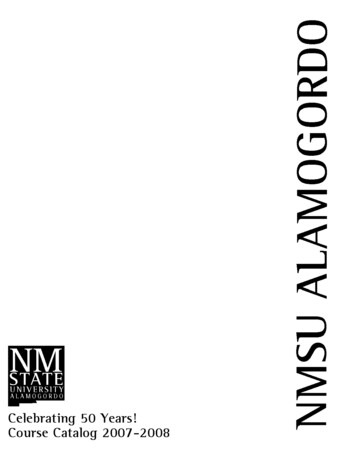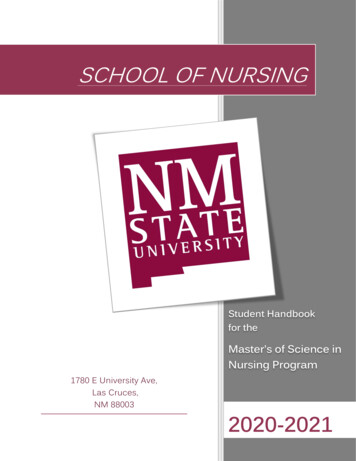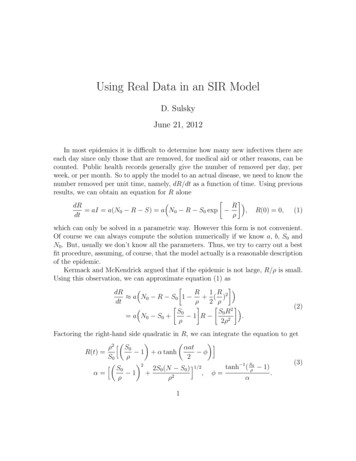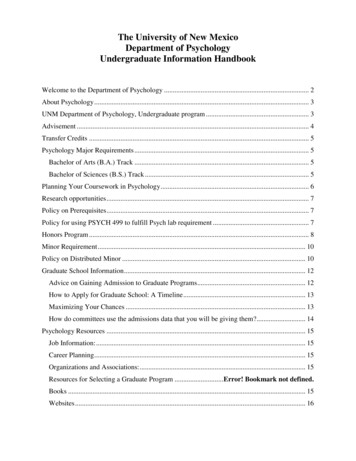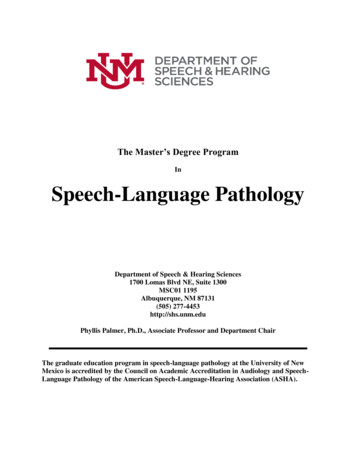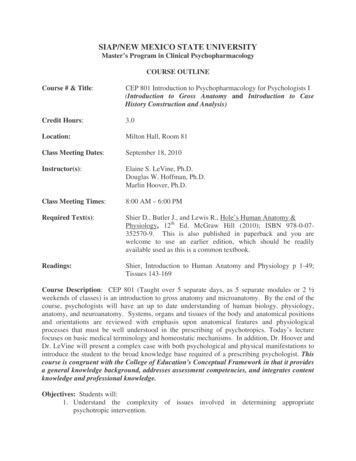
Transcription
SIAP/NEW MEXICO STATE UNIVERSITYMaster’s Program in Clinical PsychopharmacologyCOURSE OUTLINECourse # & Title:CEP 801 Introduction to Psychopharmacology for Psychologists I(Introduction to Gross Anatomy and Introduction to CaseHistory Construction and Analysis)Credit Hours:3.0Location:Milton Hall, Room 81Class Meeting Dates:September 18, 2010Instructor(s):Elaine S. LeVine, Ph.D.Douglas W. Hoffman, Ph.D.Marlin Hoover, Ph.D.Class Meeting Times:8:00 AM – 6:00 PMRequired Text(s):Shier D., Butler J., and Lewis R., Hole’s Human Anatomy &Physiology, 12th Ed. McGraw Hill (2010); ISBN 978-0-07352570-9. This is also published in paperback and you arewelcome to use an earlier edition, which should be readilyavailable used as this is a common textbook.Readings:Shier, Introduction to Human Anatomy and Physiology p 1-49;Tissues 143-169Course Description: CEP 801 (Taught over 5 separate days, as 5 separate modules or 2 ½weekends of classes) is an introduction to gross anatomy and microanatomy. By the end of thecourse, psychologists will have an up to date understanding of human biology, physiology,anatomy, and neuroanatomy. Systems, organs and tissues of the body and anatomical positionsand orientations are reviewed with emphasis upon anatomical features and physiologicalprocesses that must be well understood in the prescribing of psychotropics. Today’s lecturefocuses on basic medical terminology and homeostatic mechanisms. In addition, Dr. Hoover andDr. LeVine will present a complex case with both psychological and physical manifestations tointroduce the student to the broad knowledge base required of a prescribing psychologist. Thiscourse is congruent with the College of Education's Conceptual Framework in that it providesa general knowledge background, addresses assessment competencies, and integrates contentknowledge and professional knowledge.Objectives: Students will:1. Understand the complexity of issues involved in determining appropriatepsychotropic intervention.
2. Will have a new appreciation for how patient’s underlying medical conditions mustbe considered in the use of medications.3. Begin to learn how side effects of certain medications can actually assist in bothpsychological and medical symptomology.4. Understand and be able to communicate using appropriate medical terminology fororgan parts and positions.Evaluation: There will be a test (multiple choice, short answer or true/false) which will begiven at the end of each day. The answers will be reviewed in class. Students’ experiential casestudies will be graded on pass/fail with the expectation for a demonstration of a high levelcompetence of the biopsychosocial model of care. The grades on the standardized tests willconstitute two-thirds of the grade and the grade on the case studies one-third of the grade foreach course.GradingAssignmentsTests (5 @ 12 pts ea, 90% 12pts, 80% 11 pts, 70% 10 pts)Experiential case studies (30 pts)Points Possible60 pts.30 pts.Course grades70 pts total “A” course grade60 pts total “B” course grade50 pts total “C” course gradeStudents with Disabilities: If you have or believe you have a disability, you may wish to selfidentify. You can do so by providing documentation to the Office for Services for Studentswith Disabilities, located at Garcia Annex (telephone: 646-6840). Appropriateaccommodations may then be provided for you. If you have a condition which may affect yourability to exit from the premises in an emergency or which may cause an emergency duringclass, you are encouraged to discuss this in confidence with the instructor and/or the directorof Disabled Student Programs. If you have questions about the Americans with DisabilitiesAct (ADA), call 646-3635.
SIAP/NEW MEXICO STATE UNIVERSITYMaster’s Program in Clinical PsychopharmacologyCOURSE OUTLINECourse # & Title:CEP 801 Introduction to Psychopharmacology for Psychologists I(Introduction to Gross Anatomy and Introduction to CaseHistory Construction and Analysis)Credit Hours:3.0Location:Milton Hall, Room 81Class Meeting Dates:September 19, 2010Instructor(s):Elaine S. LeVine, Ph.D.Douglas W. Hoffman, Ph.D.Marlin Hoover, Ph.D.Class Meeting Times:8:00 AM – 3:00 PMRequired Text(s):Shier D., Butler J., and Lewis R., Hole’s Human Anatomy &Physiology, 12th Ed. McGraw Hill (2010); ISBN 978-0-07352570-9. This is also published in paperback and you arewelcome to use an earlier edition, which should be readilyavailable used as this is a common textbook.Readings:Shier, Unit 2: 170-352Course Description: CEP 801 is an introduction to gross anatomy and microanatomy. By theend of the course, psychologists will have an up to date understanding of human biology,physiology, anatomy, and neuroanatomy. Systems, organs and tissues of the body andanatomical positions and orientations are reviewed with emphasis upon anatomical features andphysiological processes that must be well understood in the prescribing of psychotropics. Thissecond day will provide students with an in depth understanding of morphology at the cellularand structural level, with particular emphasis on interactive processes. This course is congruentwith the College of Education's Conceptual Framework in that it provides a generalknowledge background, addresses assessment competencies, and integrates content knowledgeand professional knowledge.Objectives: Students will:1. Review and increase understanding of morphology on the cellular, tissue and grosslevels.2. Be able to explicate homeostatic mechanisms involved in each system.
3. Develop extensive understanding of feedback mechanisms among systems.4. Understand and be able to communicate using appropriate medical terminology for organparts and body positions.Evaluation: There will be a test (multiple choice, short answer or true/false) which will begiven at the end of each day. The answers will be reviewed in class. Students’ experiential casestudies will be graded on pass/fail with the expectation for a demonstration of a high levelcompetence of the biopsychosocial model of care. The grades on the standardized tests willconstitute two-thirds of the grade and the grade on the case studies one-third of the grade foreach course.GradingAssignmentsTests (5 @ 12 pts ea, 90% 12pts, 80% 11 pts, 70% 10 pts)Experiential case studies (30 pts)Points Possible60 pts.30 pts.Course grades70 pts total “A” course grade60 pts total “B” course grade50 pts total “C” course gradeStudents with Disabilities: If you have or believe you have a disability, you may wish to selfidentify. You can do so by providing documentation to the Office for Services for Studentswith Disabilities, located at Garcia Annex (telephone: 646-6840). Appropriateaccommodations may then be provided for you. If you have a condition which may affect yourability to exit from the premises in an emergency or which may cause an emergency duringclass, you are encouraged to discuss this in confidence with the instructor and/or the directorof Disabled Student Programs. If you have questions about the Americans with DisabilitiesAct (ADA), call 646-3635.
SIAP/NEW MEXICO STATE UNIVERSITYMaster’s Program in Clinical PsychopharmacologyCOURSE OUTLINECourse # & Title:CEP 801 Introduction to Psychopharmacology for Psychologists I(Introduction to Neuroanatomy and Chemical Anatomy of theNervous System)Credit Hours:3.0Location:Milton Hall, Room 81Class Meeting Dates:October 16, 2010Instructor(s):Douglas W. Hoffman, Ph.D.Class Meeting Times:8:00 AM – 6:00 PMRequired Text(s):Shier D., Butler J., and Lewis R., Hole’s Human Anatomy &Physiology, 12th Ed. McGraw Hill (2010).Readings:Nervous System 1 & II p 353-436Course Description: The next 3 days of classes of CEP 801 constitute a thorough study ofgross, micro and chemical anatomy of the nervous system. The structural anatomy of thecerebral cortex, sub cortex, brainstem, spinal cord and autonomic nervous system will also bediscussed in regards to the ways in which these structures interact with psychopharmacologicalagents. Special focus will be given to the structural aspects of the frontal cortex, hippocampus,basal ganglia, thalamus and hypothalamus with particular attention to the locus coerulus, dorsalraphe nuclei and the nucleus accumbens. The function of neurotransmitter systems will becategorized according to the pharmacological agents which affect them and according to theways in which they interact with a variety of anatomical pathways. This course is congruentwith the College of Education's Conceptual Framework in that it provides a generalknowledge background, addresses assessment competencies, and integrates content knowledgeand professional knowledge.Objectives: Students will:1. Develop extensive understandings of feedback mechanisms among systems.2. Learn the basics of the synthesis of neurotransmitters, protein hormones, enzymes, andother organic substances.3. Learn the chemical and electrical properties involved in neurotransmission.4. Learn the functions and importance of the peripheral and autonomic nervous systems.
Evaluation: There will be a test (multiple choice, short answer or true/false) which will begiven at the end of each day. The answers will be reviewed in class. Students’ experiential casestudies will be graded on pass/fail with the expectation for a demonstration of a high levelcompetence of the biopsychosocial model of care. The grades on the standardized tests willconstitute two-thirds of the grade and the grade on the case studies one-third of the grade foreach course.GradingAssignmentsTests (5 @ 12 pts ea, 90% 12pts, 80% 11 pts, 70% 10 pts)Experiential case studies (30 pts)Points Possible60 pts.30 pts.Course grades70 pts total “A” course grade60 pts total “B” course grade50 pts total “C” course gradeStudents with Disabilities: If you have or believe you have a disability, you may wish to selfidentify. You can do so by providing documentation to the Office for Services for Studentswith Disabilities, located at Garcia Annex (telephone: 646-6840). Appropriateaccommodations may then be provided for you. If you have a condition which may affect yourability to exit from the premises in an emergency or which may cause an emergency duringclass, you are encouraged to discuss this in confidence with the instructor and/or the directorof Disabled Student Programs. If you have questions about the Americans with DisabilitiesAct (ADA), call 646-3635.
SIAP/NEW MEXICO STATE UNIVERSITYMaster’s Program in Clinical PsychopharmacologyCOURSE OUTLINECourse # & Title:CEP 801 Introduction to Psychopharmacology for Psychologists I(Introduction to Neuroanatomy and Chemical Anatomy of theNervous System)Credit Hours:3.0Location:Milton Hall, Room 81Class Meeting Dates:October 17, 2010Instructor(s):TBAClass Meeting Times:8:00 AM – 3:00 PMRequired Text(s):Dissection Manual – Hanover College (Provided)Course Description: This class will involve a complete dissection of the brain and spinal cord.Students will develop the dimensional understanding of the placement of different structuralaspects of the brain and the ways that the neurons distribute throughout the structures throughthis hands-on experience.Objectives:Students will:1. Be able to point to the frontal cortex, hippocampus, amygdale, basal ganglia,thalamus and hypothalamus, locus coerulus, dorsal raphe nuclei, other relevant nucleiand nucleus accumbens.2. Be able to locate and trace the brain stem and examine the spinal column3. Be able to locate the cranial nerves and their attachment locations.4. Be able to trace the blood supply of the brain.5. Be able to trace the ventricles.6. Be able to identify the anatomical features and trace the neuronal pathways associatedwith anxiety disorders, depression, cognitive decline, substance abuse andschizophrenia.7. Be able to compare the various areas of the sheep brain (cerebrum, brain stem, andcerebellum) to the human brain.Evaluation: There will be a test (multiple choice, short answer or true/false) which will begiven at the end of each day. The answers will be reviewed in class. Students’ experiential casestudies will be graded on pass/fail with the expectation for a demonstration of a high levelcompetence of the biopsychosocial model of care. The grades on the standardized tests will
constitute two-thirds of the grade and the grade on the case studies one-third of the grade foreach course.GradingAssignmentsTests (5 @ 12 pts ea, 90% 12pts, 80% 11 pts, 70% 10 pts)Experiential case studies (30 pts)Points Possible60 pts.30 pts.Course grades70 pts total “A” course grade60 pts total “B” course grade50 pts total “C” course gradeStudents with Disabilities: If you have or believe you have a disability, you may wish to selfidentify. You can do so by providing documentation to the Office for Services for Studentswith Disabilities, located at Garcia Annex (telephone: 646-6840). Appropriateaccommodations may then be provided for you. If you have a condition which may affect yourability to exit from the premises in an emergency or which may cause an emergency duringclass, you are encouraged to discuss this in confidence with the instructor and/or the directorof Disabled Student Programs. If you have questions about the Americans with DisabilitiesAct (ADA), call 646-3635.
SIAP/NEW MEXICO STATE UNIVERSITYMaster’s Program in Clinical PsychopharmacologyCOURSE OUTLINECourse # & Title:CEP 801 Introduction to Psychopharmacology for Psychologists I(Introduction to Neuroanatomy and Chemical Anatomy of theNervous System)Credit Hours:3.0Location:Milton Hall, Room 81Class Meeting Dates:November 13, 2010Instructor(s):Douglas W. Hoffman, Ph.D.Class Meeting Times:8:00 AM – 6:00 PMRequired Text(s):Shier D., Butler J., and Lewis R., Hole’s Human Anatomy &Physiology, 12th Ed. McGraw Hill (2010).Readings:Nervous System III p 437-481; Endocrine System 482-521.Course Description: Today’s class completes the overview of gross, micro and chemicalanatomy of the nervous system. The structural anatomy of the cerebral cortex, sub cortex,brainstem, spinal cord and autonomic nervous system will also be discussed in regards to theways in which these structures interact with psychopharmacological agents. Special focus will begiven to the structural aspects of the frontal cortex, hippocampus, basal ganglia, thalamus andhypothalamus with particular attention to the locus coerulus, dorsal raphe nuclei and the nucleusaccumbens. The function of neurotransmitter systems will be categorized according to thepharmacological agents which affect them and according to the ways in which they interact witha variety of anatomical pathways. This course is congruent with the College of Education'sConceptual Framework in that it provides a general knowledge background, addressesassessment competencies, and integrates content knowledge and professional knowledge.Objectives: Students will:1. Develop extensive knowledge of normal systems functioning.2. Learn the localization and functions of different neurotransmitter systems in thecentral and peripheral nervous systems.3. Learn neuromorphology on the cellular and central nervous system levels.Evaluation: There will be a test (multiple choice, short answer or true/false) which will begiven at the end of each day. The answers will be reviewed in class. Students’ experiential casestudies will be graded on pass/fail with the expectation for a demonstration of a high level
competence of the biopsychosocial model of care. The grades on the standardized tests willconstitute two-thirds of the grade and the grade on the case studies one-third of the grade foreach course.GradingAssignmentsTests (5 @ 12 pts ea, 90% 12pts, 80% 11 pts, 70% 10 pts)Experiential case studies (30 pts)Points Possible60 pts.30 pts.Course grades70 pts total “A” course grade60 pts total “B” course grade50 pts total “C” course gradeStudents with Disabilities: If you have or believe you have a disability, you may wish to selfidentify. You can do so by providing documentation to the Office for Services for Studentswith Disabilities, located at Garcia Annex (telephone: 646-6840). Appropriateaccommodations may then be provided for you. If you have a condition which may affect yourability to exit from the premises in an emergency or which may cause an emergency duringclass, you are encouraged to discuss this in confidence with the instructor and/or the directorof Disabled Student Programs. If you have questions about the Americans with DisabilitiesAct (ADA), call 646-3635.
SIAP/NEW MEXICO STATE UNIVERSITYMaster’s Program in Clinical PsychopharmacologyCOURSE OUTLINECourse # & Title:CEP 802 Introduction to Chemistry and Biochemistryfor the Prescribing PsychologistCredit Hours:3.0Location:Milton Hall, Room 81Class Meeting Dates:November 14, 2010Instructor(s):Douglas W. Hoffman, Ph.D.Class Meeting Times:8:00 AM – 3:00 PMRequired Text(s):Shier D., Butler J., and Lewis R., Hole’s Human Anatomy &Physiology, 12th Ed. McGraw Hill (2010).Readings:Chemical Basis of Life p 50-74; Cells p75-113; Water p 810-829Course Description: CEP 802 (taught as 5 modules over 5 days, for 2 ½ weekends) providesstudents with a review of those aspects of chemistry, organic chemistry and biochemistry whichare needed for the study of pharmacology. In general chemistry, the concepts of chemicalcompounds and bonds, and atomic theory will be reviewed. In organic chemistry, the conceptsof organic compounds, bonds and valences will be reviewed. In biochemistry, biomolecules ofproteins, carbohydrates, nucleic acids and lipids, as well as chromosomal theory and the geneticcode, enzymes and metabolism will be covered. This course will review and update student’sunderstanding of critical principles in biochemistry, including: chemical compounds and bonds(covalent, ionic, hydrophilic/hydrophobic, hydrogen bonds); atomic theory; organic compounds,bonds and valences; biomolecules (proteins, carbohydrates, nucleic acids and lipids); enzymesand metabolism; transport processes in neurons; and biochemical mechanisms of neuronalsignaling.Today’s class will cover the following topics in the order below:atomic theorychemical compounds and bonds (covalent, ionic, hydrophilic/hydrophobic, hydrogenbonds)organic compounds, bonds and valencesbiomolecules (proteins, carbohydrates, nucleic acids and lipids)enzymes and metabolism
Evaluation: There will be a test (multiple choice, short answer or true/false) which will begiven at the end of each day. The answers will be reviewed in class. Students’ experiential casestudies will be graded on pass/fail with the expectation for a demonstration of a high levelcompetence of the biopsychosocial model of care. The grades on the standardized tests willconstitute two-thirds of the grade and the grade on the case studies one-third of the grade foreach course.GradingAssignmentsTests (5 @ 12 pts ea, 90% 12pts, 80% 11 pts, 70% 10 pts)Experiential case studies (30 pts)Points Possible60 pts.30 pts.Course grades70 pts total “A” course grade60 pts total “B” course grade50 pts total “C” course gradeStudents with Disabilities: If you have or believe you have a disability, you may wish to selfidentify. You can do so by providing documentation to the Office for Services for Studentswith Disabilities, located at Garcia Annex (telephone: 646-6840). Appropriateaccommodations may then be provided for you. If you have a condition which may affect yourability to exit from the premises in an emergency or which may cause an emergency duringclass, you are encouraged to discuss this in confidence with the instructor and/or the directorof Disabled Student Programs. If you have questions about the Americans with DisabilitiesAct (ADA), call 646-3635.
SIAP/NEW MEXICO STATE UNIVERSITYMaster’s Program in Clinical PsychopharmacologyCOURSE OUTLINECourse # & Title:CEP 802 Introduction to Chemistry and Biochemistry for thePrescribing PsychologistCredit Hours:3.0Location:Milton H
of Disabled Student Programs. If you have questions about the Americans with Disabilities Act (ADA), call 646-3635. SIAP/NEW MEXICO STATE UNIVERSITY Master’s Program in Clinical Psychopharmacology COURSE OUTLINE Course # & Title: CEP 8


